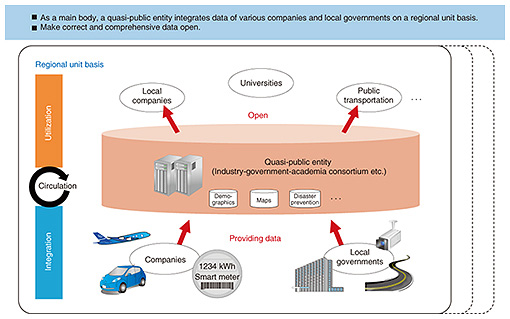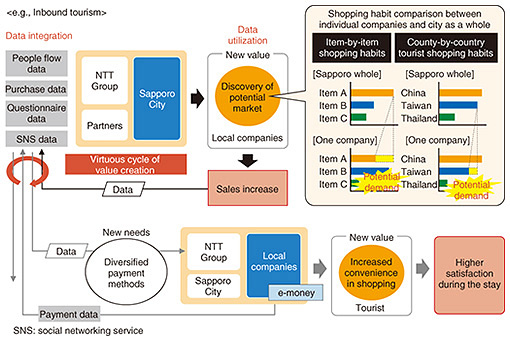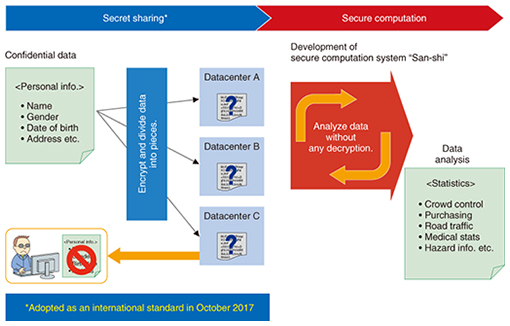 |
|||||||
|
|
|||||||
|
Feature Articles: Keynote Speeches at NTT R&D Forum 2018 Vol. 16, No. 4, pp. 1–8, Apr. 2018. https://doi.org/10.53829/ntr201804fa1  Co-creating a Virtuous Cycle of New ValueOverviewIn this article, we introduce NTT Group’s initiatives for B2B2X (business-to-business-to-X) models and acceleration of Society 5.0 through co-creation of new value. The contents of this article are based on a lecture given by Hiroo Unoura, NTT President and Chief Executive Officer, at NTT R&D Forum 2018 held in February 2018. Keywords: B2B2X, Society 5.0, data integration and utilization 1. Social issues in JapanJapan has long been said to be an issue-facing developed country, but unfortunately, it has yet to become an issue-solving developed country. These social issues include a falling population, super-aging society, deteriorating infrastructure, urban concentration, and environmental problems. The government report entitled Growth Strategy 2017 issued by the Cabinet Office states that the key to overcoming these issues and achieving medium- and long-term growth is to introduce innovative technologies of the Fourth Industrial Revolution such as the Internet of Things (IoT), big data, and artificial intelligence (AI) into all sorts of industries and every corner of social life. In other words, the goal is to realize Society 5.0, which aims to solve diverse social challenges through the use of advanced technologies. As information and communication technology (ICT) continues to progress together with accelerated use of networks and IoT, varieties of national strategies have been established throughout the world with the aim of maximizing the use of ICT in the field of manufacturing and bringing about change in the form of the Fourth Industrial Revolution. These include Industry 4.0 in Germany, the Advanced Manufacturing Partnership in the United States, and Made in China 2025 in China. Japan, meanwhile, is promoting a national strategy called Society 5.0 with the aim of digitizing not just manufacturing but also government, industry, and society through the development of innovative technologies and the use of diverse types of data [1]. Against this background, the Japan Business Federation (Keidanren) envisions a society having the following features as part of the Society 5.0 initiative: (1) Smart society undaunted by population decreases (2) Society in which individuals can actively participate, including the elderly and women (3) Safe, secure society in both cyberspace and physical space (4) Society where cities and regions are linked and it is possible to live comfortably anywhere (5) Sustainable society that balances the economy and environment In Society 5.0, solutions will be formulated to deal with social issues such as the falling population in the agricultural/farming industry and a decrease in industrial competitiveness. For example, sensors could be installed in fields to collect a wide variety of data (big data) on the growing environment of harvested crops, and such data combined with meteorological data could be analyzed using AI to improve productivity. Society 5.0 is a world in which society on the whole is optimized through the use of data and the convergence of cyberspace and physical space. It will be achieved through the digital transformation of various sectors in society. Digital transformation means leveraging ICT tools to accumulate diverse data and using that data in management activities to create new business models and change existing business practices. Digital transformation is a concept first proposed by Swedish professor Erik Stolterman in 2004. Since then, the ICT environment surrounding digital transformation and the systems used for handling data have changed considerably. Examples include the evolution of AI and IoT as ICT tools and the introduction of edge computing to achieve distributed and high-speed data processing. At the same time, the volume of traffic data has increased considerably, and network bandwidth supporting that data flow has expanded. Cybersecurity technologies and legislation in relation to the integration and utilization of data have also progressed. In the face of these environmental changes, digital transformation is moving from a conceptual stage to a practical stage (Fig. 1).
2. B2B2X (business-to-business-to-X) modelsThe world of Society 5.0 will be achieved through the digital transformation of various sectors in society. To this end, the NTT Group is committed to supporting digital transformation in companies and local governments with the aim of creating new value. 2.1 Direction of initiatives for B2B2X modelsThe NTT Group seeks to accelerate the creation of new value by promoting collaboration with diverse service providers. In our B2B2X models, we will support the digital transformation of a wide variety of service providers (the second ‘B’ in B2B2X) as a valuable supporting player with the aim of contributing to lifestyle changes and solving social issues. We have numerous services and ICT tools that can support companies and local governments in their digital transformation. For example, in addition to our traditional strength in telecommunications infrastructures, we can provide main players (service providers) with services and ICT tools that make use of AI-related technologies such as those for speech/language processing and data analysis, as well as edge computing technologies, all cultivated through NTT research and development (R&D) efforts. I believe that efforts such as these will generate new value for users (the ‘X’ in B2B2X) that can lead to lifestyle changes and solutions to social issues (Fig. 2). Just last year, we started new collaborative projects with a variety of service providers in diverse sectors from healthcare to automobiles, transport, manufacturing, agriculture, and tourism.
2.2 Kabuki that merges reality and virtualityIn the area of traditional performing arts, we are creating new value going beyond the boundaries of time and space through a collaborative effort between SHOCHIKU Co., Ltd. and NTT, using NTT’s R&D technology. At the Niconico Chokaigi festival hosted by Dwango Co., Ltd. held in April 2016 and April 2017, SHOCHIKU presented a public performance of “Cho-Kabuki” incorporating NTT’s immersive telepresence technology called Kirari!. In this program, the kabuki actor Nakamura Shido II appeared on stage together with the vocaloid Hatsune Miku. By providing programs with such novel performances, SHOCHIKU has been able to attract the interest of young people and expand its kabuki fan base. Then, in March 2017, NTT collaborated with the Kumamoto prefectural government in holding a Virtual Kabuki Theater as part of a prayer for recovery in the wake of the 2016 Kumamoto earthquakes. Through this effort, we were able to provide performances at a theater not specialized for kabuki and to expand theatergoing opportunities for the general public. More recently in November 2017, NTT provided support for a presentation of “Miyako Musubi Yume-no Renjishi” by the kabuki actors Nakamura Shikan VIII, Nakamura Hashinosuke IV, Nakamura Fukunosuke III, and Nakamura Utanosuke IV as the first kabuki performance merging reality and virtuality. In this presentation, the three actors other than Nakamura Shikan performed their roles at the Miyakawacho Kaburenjo Theater in Kyoto, which was located about 1.5 km from the Pontocho Kaburenjo Theater where Nakamura Shikan was performing. We transmitted the video of those three actors in real time to the Pontocho Kaburenjo Theater to achieve a virtual co-performance of the Renjishi kabuki dance by Nakamura Shikan and his three fellow actors. Using NTT technology in this way made it possible for actors in different locations to perform as if they were all present in the same place (Fig. 3).
3. Initiatives toward the acceleration of Society 5.0In this article, I have so far introduced NTT Group initiatives (B2B2X models) for achieving Society 5.0. From here on, I will introduce initiatives for accelerating the realization of Society 5.0. Digital transformation efforts are progressing at various companies and enterprises. These activities, however, are essentially independent of each other, with the result that most are not cross-sector efforts. I believe that we can accelerate the coming of Society 5.0 by promoting digital transformation across sectors instead of focusing only on individual fields or industries. In short, what is of importance here is to establish an environment for integrating and opening up data across sectors and for utilizing that data effectively. 3.1 Current status and direction of data integration and utilizationAt present, the dominant trend in Japan is for companies and local governments to integrate data individually in a fragmented manner. The data that we possess, while being of very high quality, is perhaps small in volume compared with that of the global digital giants. However, if high quality data from several sources can be appropriately combined into mashups, it should be possible to speed up the digital transformation process (Fig. 4).
Let us consider reform of the agricultural sector as an example. First of all, simply applying a digital transformation to agricultural production is not sufficient in itself for improving agricultural output or food safety. A cross-sector approach that includes distribution of raw materials, food processing, distribution of processed foods, and other elements, is important. However, a mechanism for integrating and opening up essential data across various sectors in a digital transformation is unclear. This is a major issue in promoting Society 5.0 from here on. In countries such as the United States and China, digital giants are advancing the integration and use of data. Unfortunately, in Japan, I believe this approach would be difficult to pursue. It is therefore important that we consider what other methodologies might be available and what direction solutions might take. Simply accumulating data is not the objective; the prime objective is to use the data properly. The issue of whom data belongs to is also being debated. Does it belong to the service provider that collected the data or to the individuals who created that data? It is my belief that data belongs to society, to the people making up a community. In other words, I consider that data should be used for promoting progress in regional communities. 3.2 New ecosystemA new ecosystem is needed to accelerate Society 5.0 and promote the digitization of industry and society through the use of data. This ecosystem would not be on a municipal or even prefectural level; rather, it would be based on regional units each of a scale of several million people. In this ecosystem, data in each regional unit would be managed by a quasi-public entity (e.g., an industry-government-academia consortium) that would promote the integration of data and the provision of open data. The reason here for regional units is that social problems tend to be regional in nature, and the reason for having a quasi-public entity at the center of this ecosystem is that government needs to play a central role in finding solutions to social issues. The collection of data by the government for the purpose of solving social issues is a worthy endeavor. In addition, a public entity can be neutral with respect to corporate enterprises and can take on the responsibility of ensuring security. I would like to create an ecosystem that converts correct and comprehensive data to open data, which can then be accessed and used by companies and venture-funded startups to create new value (Fig. 5).
I would also like to create a mechanism that would provide companies with an incentive to proactively provide data. In this mechanism, only companies that provide data to the quasi-public entity or that provide the results of using that data would be able to reference the big data held by the quasi-public entity. Creation of such an ecosystem with value enables even global digital giants to circulate the data they possess within that region in exchange for allowing them to reference the correct data. I believe that doing so would enable the creation of a self-reliant region and a society with a global presence. 3.3 Initiatives in Sapporo for value creationWe are supporting Sapporo City, Hokkaido, in its efforts to integrate and open up data as a first step toward achieving an ecosystem within a regional unit. Since concluding the Sapporo Town Planning Partner Agreement with Sapporo City in September 2015, we have been supporting Sapporo in its efforts to solve social issues in that region. In addition, the Sapporo City ICT Utilization Platform Study Panel was established in July 2016 with members coming from local companies, governments, and universities. This study panel was set up to study data integration and utilization guidelines, platform requirements, and an operational framework for the platform. The use of ICT in sports/tourism, traffic and snow-control measures, and health is being studied in separate subcommittees. (1) Value creation by data integration and utilization Here, I would like to introduce an example of data utilization by Sapporo City in the area of inbound tourism. This initiative began with the integration and utilization of data from three companies, namely, a department store, supermarket, and drugstore. These companies provided data that they possessed on purchases made by tourists resulting in a database of purchase data for all of Sapporo. Each company could then compare its own purchase data with overall purchase data and thereby observe purchase trends that had gone unnoticed. In this way, each company could discover potential markets and increase sales by modifying its marketing strategy. Since this initial effort, Sapporo has added other types of companies such as hotels, bringing the scale of participants to about 20 firms. From here on, the plan is to circulate the activities and results of each company back to Sapporo as data and to reconvert that information into open data that can be used to create new value. Additionally, I believe that the introduction of e-money by local companies can respond to the need for diversified payment methods; that is, it can make shopping more convenient for tourists, thereby creating new value. In addition to reducing the cash handling costs of local companies, the digitization of payment methods can broaden the range of payment information that can be obtained as digital data, which should enable more effective sales promotions (Fig. 6).
In another initiative, we are formulating plans for collecting and analyzing data on road conditions during the snow season with the aim of operating snow plows more efficiently and providing Sapporo residents with snow-removal updates. (2) ICT utilization platform The results of these initiatives have been used to create the website “Sapporo City ICT Utilization Platform Data-Smart City Sapporo,” which came online on January 31, 2018, under the management of the Sapporo Electronics and Industries Cultivation Foundation [2]. This website can be used by local companies and residents to access data from the public and private sectors integrated on the platform. It is helping to create an environment that provides users with content generated by the analysis of collected data and enables the sharing, comparison, and analysis of data among companies. The leadership demonstrated in this way by Sapporo City in promoting the integration and opening up of data is driving the use of data by local companies and the creation of new value for the region. Going forward, we expect the integration of cross-sector data, the broadening of data utilization, and the creation of new value to create a combined effect accelerating the solving of social issues. I also envision the expansion of this Sapporo initiative to an even larger regional unit such as Hokkaido in total. This could result in even more effective integration and utilization of data. Moreover, I think that the results of competition among multiple regional units could be spread throughout Japan, thereby accelerating the drive toward Society 5.0. (3) Secret sharing and secure computation An example of security technologies supporting data integration and utilization is secret sharing technology and secure computation technology developed by the NTT laboratories. NTT secret sharing technology was adopted as the first international standard in this field by the International Organization for Standardization (ISO) in October 2017 [3]. NTT secure computation technology, meanwhile, provides robust security by dividing encrypted data among multiple servers in a distributed storage scheme. This technology also makes it possible to analyze and process that data directly in its distributed and encrypted form. Using these technologies to store information in distributed form among multiple datacenters prevents information leaks even if the data stored at one of those datacenters should be stolen. In fact, data can be restored even if the data at one of the datacenters are lost due to a natural disaster or other calamity. Stored data may be analyzed without having to restore the data to the original form (Fig. 7).
4. Toward the realization of Society 5.0As we go forward, the NTT Group is committed to supporting digital transformation across diverse sectors as a value partner. We will promote the creation of an environment for integrating, opening up, and utilizing data across sectors based on a new ecosystem to accelerate the realization of Society 5.0. References
Trademark notesAll brand names, product names, and company names that appear in this article are trademarks or registered trademarks of their respective owners. |
|||||||







